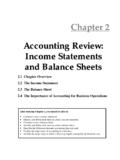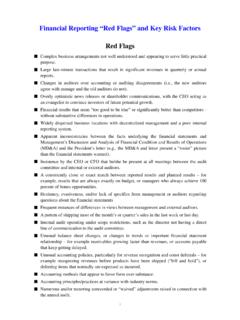Transcription of Solutions Manual - Georgia State University
1 1 Solutions Manual Corporate Finance Ross, Westerfield, and Jaffe 9th edition 2 CHAPTER 1 INTRODUCTION TO CORPORATE FINANCE Answers to Concept Questions 1. In the corporate form of ownership, the shareholders are the owners of the firm. The shareholders elect the directors of the corporation, who in turn appoint the firm s management. This separation of ownership from control in the corporate form of organization is what causes agency problems to exist. Management may act in its own or someone else s best interests, rather than those of the shareholders. If such events occur, they may contradict the goal of maximizing the share price of the equity of the firm. 2. Such organizations frequently pursue social or political missions, so many different goals are conceivable. One goal that is often cited is revenue minimization; , provide whatever goods and services are offered at the lowest possible cost to society.
2 A better approach might be to observe that even a not-for-profit business has equity. Thus, one answer is that the appropriate goal is to maximize the value of the equity. 3. Presumably, the current stock value reflects the risk, timing, and magnitude of all future cash flows, both short-term and long-term. If this is correct, then the statement is false. 4. An argument can be made either way. At the one extreme, we could argue that in a market economy, all of these things are priced. There is thus an optimal level of, for example, ethical and/or illegal behavior, and the framework of stock valuation explicitly includes these. At the other extreme, we could argue that these are non-economic phenomena and are best handled through the political process. A classic (and highly relevant) thought question that illustrates this debate goes something like this: A firm has estimated that the cost of improving the safety of one of its products is $30 million.
3 However, the firm believes that improving the safety of the product will only save $20 million in product liability claims. What should the firm do? 5. The goal will be the same, but the best course of action toward that goal may be different because of differing social, political, and economic institutions. 6. The goal of management should be to maximize the share price for the current shareholders. If management believes that it can improve the profitability of the firm so that the share price will exceed $35, then they should fight the offer from the outside company. If management believes that this bidder or other unidentified bidders will actually pay more than $35 per share to acquire the company, then they should still fight the offer. However, if the current management cannot increase the value of the firm beyond the bid price, and no other higher bids come in, then management is not acting in the interests of the shareholders by fighting the offer.
4 Since current managers often lose their jobs when the corporation is acquired, poorly monitored managers have an incentive to fight corporate takeovers in situations such as this. 3 7. We would expect agency problems to be less severe in other countries, primarily due to the relatively small percentage of individual ownership. Fewer individual owners should reduce the number of diverse opinions concerning corporate goals. The high percentage of institutional ownership might lead to a higher degree of agreement between owners and managers on decisions concerning risky projects. In addition, institutions may be better able to implement effective monitoring mechanisms on managers than can individual owners, based on the institutions deeper resources and experiences with their own management. 8. The increase in institutional ownership of stock in the United States and the growing activism of these large shareholder groups may lead to a reduction in agency problems for corporations and a more efficient market for corporate control.
5 However, this may not always be the case. If the managers of the mutual fund or pension plan are not concerned with the interests of the investors, the agency problem could potentially remain the same, or even increase since there is the possibility of agency problems between the fund and its investors. 9. How much is too much? Who is worth more, Ray Irani or Tiger Woods? The simplest answer is that there is a market for executives just as there is for all types of labor. Executive compensation is the price that clears the market. The same is true for athletes and performers. Having said that, one aspect of executive compensation deserves comment. A primary reason executive compensation has grown so dramatically is that companies have increasingly moved to stock-based compensation. Such movement is obviously consistent with the attempt to better align stockholder and management interests.
6 In recent years, stock prices have soared, so management has cleaned up. It is sometimes argued that much of this reward is simply due to rising stock prices in general, not managerial performance. Perhaps in the future, executive compensation will be designed to reward only differential performance, , stock price increases in excess of general market increases. 10. Maximizing the current share price is the same as maximizing the future share price at any future period. The value of a share of stock depends on all of the future cash flows of company. Another way to look at this is that, barring large cash payments to shareholders, the expected price of the stock must be higher in the future than it is today. Who would buy a stock for $100 today when the share price in one year is expected to be $80?
7 4 CHAPTER 4 DISCOUNTED CASH FLOW VALUATION Answers to Concepts Review and Critical Thinking Questions 1. Assuming positive cash flows and interest rates, the future value increases and the present value decreases. 2. Assuming positive cash flows and interest rates, the present value will fall and the future value will rise. 3. The better deal is the one with equal installments. 4. Yes, they should. APRs generally don t provide the relevant rate. The only advantage is that they are easier to compute, but, with modern computing equipment, that advantage is not very important. 5. A freshman does. The reason is that the freshman gets to use the money for much longer before interest starts to accrue. 6. It s a reflection of the time value of money. TMCC gets to use the $24,099 immediately. If TMCC uses it wisely, it will be worth more than $100,000 in thirty years.
8 7. This will probably make the security less desirable. TMCC will only repurchase the security prior to maturity if it is to its advantage, interest rates decline. Given the drop in interest rates needed to make this viable for TMCC, it is unlikely the company will repurchase the security. This is an example of a call feature. Such features are discussed at length in a later chapter. 8. The key considerations would be: (1) Is the rate of return implicit in the offer attractive relative to other, similar risk investments? and (2) How risky is the investment; , how certain are we that we will actually get the $100,000? Thus, our answer does depend on who is making the promise to repay. 9. The Treasury security would have a somewhat higher price because the Treasury is the strongest of all borrowers. 10. The price would be higher because, as time passes, the price of the security will tend to rise toward $100,000.
9 This rise is just a reflection of the time value of money. As time passes, the time until receipt of the $100,000 grows shorter, and the present value rises. In 2019, the price will probably be higher for the same reason. We cannot be sure, however, because interest rates could be much higher, or TMCC financial position could deteriorate. Either event would tend to depress the security s price. 5 Solutions to Questions and Problems NOTE: All-end-of chapter problems were solved using a spreadsheet. Many problems require multiple steps. Due to space and readability constraints, when these intermediate steps are included in this Solutions Manual , rounding may appear to have occurred. However, the final answer for each problem is found without rounding during any step in the problem. Basic 1.
10 The simple interest per year is: $5,000 .09 = $450 So, after 10 years, you will have: $450 10 = $4,500 in interest. The total balance will be $5,000 + 4,500 = $9,500 With compound interest, we use the future value formula: FV = PV(1 +r)t FV = $5,000( )10 = $11, The difference is: $11, 9,500 = $2, 2. To find the FV of a lump sum, we use: FV = PV(1 + r)t a. FV = $1,000( )10 = $1, b. FV = $1,000( )10 = $2, c. FV = $1,000( )20 = $3, d. Because interest compounds on the interest already earned, the interest earned in part c is more than twice the interest earned in part a. With compound interest, future values grow exponentially. 3. To find the PV of a lump sum, we use: PV = FV / (1 + r)t PV = $15,451 / ( )6 = $10, PV = $51,557 / ( )9 = $14, PV = $886,073 / ( )18 = $135, PV = $550,164 / ( )23 = $12, 6 4.















